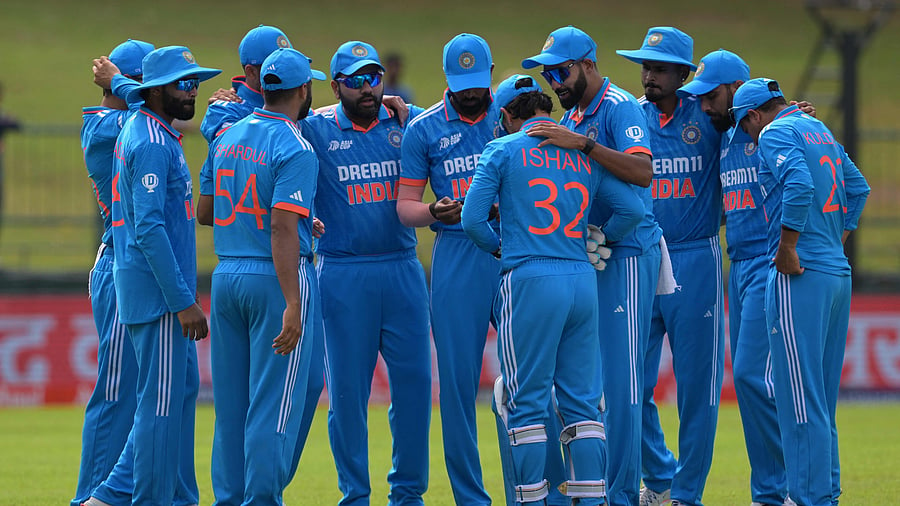
Post India’s triumph at the Asia Cup, which they lifted for a record-extending eighth time, and a series win over Australia soon after, impressions have changed and hopes are brighter.
Credit: PTI Photo
The 2007 World Cup campaign in the Caribbean remains one of the lowest moments in the history of Indian sport. The team, teeming with some of the greatest cricketers the game has seen, was one of the strong contenders to win the title but was dumped out of the event in the first week itself after defeats to Bangladesh and Sri Lanka in the group stage. Rahul Dravid was the captain of the doomed campaign, and the defeat might still be hurting the Bengalurean. As a player, he didn’t get a chance to redeem himself but as the current head coach of the Indian team, he has an opportunity to sing the redemption song.
Just ahead of the Asia Cup in Pakistan and Sri Lanka, if you had asked anyone with even a passing interest in cricket about India’s chances of winning the ICC Men’s World Cup, the answer could have ranged from an unconvincing “yes” to emphatic “no”. However, post India’s triumph at the Asia Cup, which they lifted for a record-extending eighth time, and a series win over Australia soon after, impressions have changed and hopes are brighter.
The low expectations from India prior to the Asia Cup and the Australia series weren’t without reason. Yes, a few key players were out through long injury lay-offs and a few others had to be rested on a rotation basis as part of their workload management, but the team appeared out of its depth even against sides they were expected to steamroll. Like West Indies. The experiments, whether to augment the absence of first-choice players or to form an ideal combination for the marquee event, didn’t provide encouraging results. With each failed experiment and the resultant undesirable result, hopes started to fade and frustrations began to boil over.
The Asia Cup was one final tournament to plug all the gaping holes. The timely return of pace ace Jasprit Bumrah and their first-choice wicketkeeper-batter KL Rahul helped India play their potential World Cup team in a triumphant campaign in Sri Lanka. Most of the missing pieces in the jigsaw puzzle had fallen in place but question marks over their preferred No. 4, Shreyas Iyer, and “enforcer” Suryakumar Yadav remained unresolved. Iyer’s value at No. 4 was beyond any doubt but his fitness wasn’t. And Surya, for all his T20 exploits, appeared to be a square peg trying to fit into a round hole when it came to one-dayers. The Australia series was one last chance for both Mumbaikars to be a part of the World Cup squad and the duo nailed their places with sparkling efforts.
Barring the untimely injury to Axar Patel, who has since been replaced by veteran off-spinner R Ashwin, India have the team they wanted. It has all the ingredients to emulate MS Dhoni and Co. and continue the trend of the host country winning the last three quadrennial events, starting with India’s victory in 2011.
There is a marked difference between the Class of 2011 and the present team. Where Dhoni’s team was characterised by batters who could turn their arms over for a few overs, Rohit Sharma’s unit is brimming with specialists. None of the top four can bowl and none of the bottom four (in case three pacers and Kuldeep Yadav are picked) can bat. They do have all-rounders in Hardik Pandya and Ravindra Jadeja, who are shoo-ins, but they will still have a long tail to contend with if they decide to go with Bumrah, Mohammed Siraj and Mohammed Shami. To negate this shortcoming, they have often played Shardul Thakur, who can bat a bit, ahead of Shami, but is he worth excluding an out-and-out wicket-taking bowler?
Ashwin’s late inclusion adds a new dynamic to the side. Given his limitations in the outfield, he could be used effectively as a floater based on conditions and opponents. Shubman Gill’s form at the top of the tree is one of the biggest positives as is the success of Ishan Kishan in the middle-order, who also adds left-handed variety. The Jharkhandi, however, will have to wait for his chance as Rahul is team’s No. 1 choice for the wicketkeeper-batter slot. If the Karnataka player remains injury-free, he can be a crucial cog shepherding the innings in the middle overs. The right-hander has the game and the temperament to play the situation with an ability to anchor and accelerate with remarkable ease.
Hardik Pandya, the most protected species in Indian cricket, appears to have peaked at the right time. He has it in him to reprise the role that Yuvraj Singh essayed in the 2011 World Cup.
In all probability, this will be the final World Cup for two of the finest white-ball batters of modern-day cricket -- Virat Kohli and Rohit Sharma. Both have been in sparkling form and are expected to play a pivotal part in India’s campaign not just with the bat but with their experience as well. Though rookies then, both Rohit -- who was part of the T20 World Cup winning team in 2007 -- and Kohli, who won the 50-over World Cup in his debut event, know what it takes to win a tournament of this magnitude. A winning finish is no more than what two of the greatest servants of Indian cricket deserve.
A person can’t change overnight with his success or failures. I don’t think one result or one championship can change me as a person. I have not changed as a person in the last 16 years and I don’t think anything needs to change on that front.